Content
- 1 The value and composition of badan
- 2 The healing properties of the badan plant
- 3 What is badan useful for humans
- 4 What do the berry root and leaves help with?
- 5 The use of rhizomes and leaves of badan in folk medicine
- 6 Recipes for useful compounds
- 7 Badan application
- 8 Limitations and contraindications
- 9 When and how to collect and dry badan
- 10 Conclusion
The healing properties and application of badan deserve careful consideration. The roots and leaves of the plant can serve as raw materials for the preparation of effective medicines.
The value and composition of badan
The beneficial properties of badan, which is also called thick-leaved saxifrage or Mongolian tea, are due to its rich composition. The leaves and roots of the plant contain:
- tannins - up to 35%;
- starch;
- arbutin;
- phenolic acids;
- the flavonoids kaempferol and quercetin;
- polyphenols;
- vitamin C;
- iron and manganese;
- vitamin P;
- copper;
- antioxidants.
Perennial root in folk medicine is valued more than green parts. However, the leaves are also often used for the preparation of medicines.
The healing properties of the badan plant
Broths, teas and infusions based on thick-leaved saxifrage are used for a variety of ailments. In particular, a perennial plant is used:
- to reduce pressure and strengthen the vascular walls;
- with headaches and migraines;
- with dermatitis and skin lesions;
- with laryngitis, pneumonia, whooping cough;
- with hemorrhoids and fibroids of the uterus;
- with joint ailments.
Plant-based products improve digestive processes.
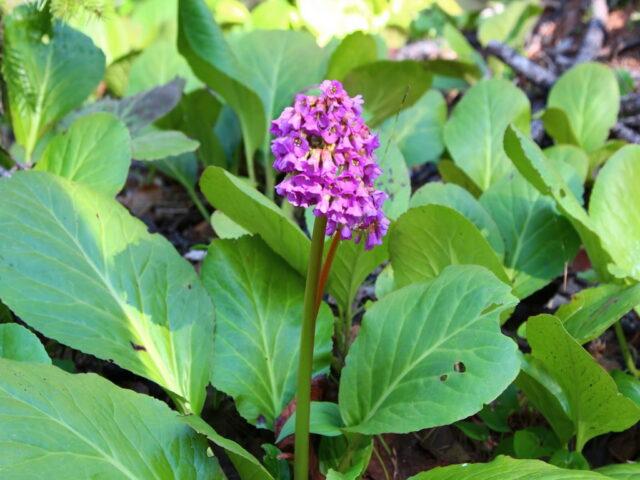
Taking infusions and decoctions of bergenia is useful for quickly strengthening immunity
Medicinal properties and contraindications of badan root
Most of all nutrients are concentrated in the root of badan. It is especially often used for:
- diarrhea;
- stomach ailments;
- weakened vessels.
The healing properties of the badan rhizome are used for external treatment of the skin and for the treatment of wounds and cuts. Compresses with plant-based ointment are good for bruising and bruising, promoting their resorption.
Why are badan leaves useful?
The green parts of the thick-leaved saxifrage are in demand in the fight against inflammation and infections. Also, decoctions and infusions based on them are beneficial for:
- hypertension;
- frequent migraines;
- respiratory diseases;
- sore throat and colds;
- kidney ailments;
- rheumatism.
The beneficial properties and contraindications of badan leaves are considered in the gynecological field. Raw materials are used to stop bleeding, it is especially valuable for women suffering from heavy periods.Medicines are used in the complex treatment of cervical erosion.
What is badan useful for humans
First of all, thick-leaved saxifrage is known for its pronounced astringent properties. Its roots and leaves contain a huge amount of tannin components - gallotannin, bergenin, isocoumarin. Healing decoctions and infusions of badan are especially beneficial for diarrhea, bleeding, colitis. They can be used for dysentery, Escherichia coli and typhoid fever.
Medicines from thick-leaved saxifrage are useful for vitamin deficiency and a tendency to anemia, bleeding gums and dental diseases. Home remedies are in demand for colds, coughs and runny nose, inflammatory and bacterial processes in the throat.
The healing properties of badan for men
Teas and decoctions based on thick-leaved saxifrage have a beneficial effect on male potency. You can use them with a weakening of libido, as well as in the complex therapy of inflammatory diseases of the reproductive system. Badan is beneficial for prostatitis and adenoma.
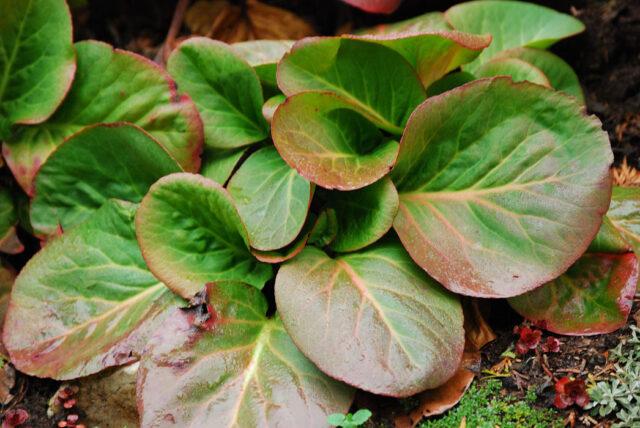
Badan prevents the development of oncological processes in men
Medicinal properties and contraindications of badan for women
The thick-leaved saxifrage is often used in the treatment of gynecological ailments. Decoctions and infusions based on the plant help to cope with inflammation of the appendages, cystitis, myoma. Healing products facilitate the course of painful periods, regulate the volume of secretions and generally improve well-being. Taking home remedies is useful for maintaining youth and beauty; bergenia has a very good effect on the condition of hair and skin.
Is it possible badan during pregnancy and hepatitis B
During the period of bearing a child and during lactation, it is not prohibited to use badan-based products. They can prevent uterine bleeding, relieve symptoms of toxicosis, and stop diarrhea. It should be borne in mind that the plant lowers blood pressure and provokes constipation, respectively, in some situations it can turn into harm.
During lactation, the benefits and harms of tea made from badan leaves, as well as decoctions from the roots, becomes ambiguous. It is undesirable to use funds, they can cause allergies or colic in an infant.
At what age can children
The healing properties of the badan herb are used for diarrhea and colds in children. But it is possible to offer herbal remedies to babies only after reaching the age of seven. The active substances in the leaves and rhizomes can harm the digestive system, and the development of allergies cannot be ruled out.
What do the berry root and leaves help with?
Traditional medicine uses thick-leaved saxifrage for the following ailments:
- tuberculosis and pneumonia;
- rheumatism and arthritis;
- goiter;
- inflammation of the oral cavity;
- diseases of the urinary tract;
- toothache;
- non-infectious colitis and enterocolitis;
- hemorrhoids;
- flu and colds;
- migraine;
- fibroma of the uterus;
- gastritis and chronic ulcers.
Externally, the medicinal plant is used for skin lesions, bruises and weeping rashes.
The use of rhizomes and leaves of badan in folk medicine
There are many recipes for the use of badan for acute and chronic diseases. Traditional medicine in particular distinguishes several of them.
Badan for diarrhea
With severe diarrhea, an infusion on the roots of a thick-leaved saxifrage provides good help. They do it like this:
- three large spoons of crushed raw materials are poured into 400 ml of hot water;
- kept under the lid for five hours;
- filter the product through folded gauze.
You need to drink the infusion three times a day, 20 ml. Improvements are noticed almost immediately.

For a full effect on diarrhea, the badan should be taken for two weeks.
With hemorrhoids
The use of badan root is indicated for hemorrhoids to relieve pain and inflammation. Such a remedy brings a good effect:
- 50 g of crushed saxifrage root are mixed in equal proportions with dried tansy;
- add the same amount of St. John's wort herb;
- in a thermos, the collection is poured with 500 ml of boiling water;
- leave for three hours.
The finished infusion is passed through cheesecloth to filter the precipitate, and poured into a large bowl with warm clean water. A sitz bath is taken for 15 minutes, the procedure must be repeated at least three times a week.
For diseases of the oral cavity
For stomatitis and periodontal disease, rinses are used using an infusion of bergenia. The healing solution is done like this:
- four large spoons of crushed rhizomes pour 500 ml of boiling water;
- kept under the lid for about 30 minutes;
- filtered.
Instructions for the use of badan rhizomes recommends rinsing your mouth with a warm product throughout the day after each meal.
With ENT diseases
With rhinitis, laryngitis and other diseases of the throat and nose, a decoction of medicinal herbs helps well. To prepare it you need:
- mix in equal volumes dried incense, St. John's wort and elecampane;
- measure out 30 g of crushed raw materials;
- pour 450 ml of hot water;
- simmer over low heat for half an hour.
The finished broth in a closed form is insisted for another day, and then filtered. You need to take the product 40 ml twice a day.
For the prevention of goiter
The thick-leaved saxifrage works well on the thyroid gland and prevents the development of endemic goiter. For medicinal purposes, a simple decoction is prepared. They do it like this:
- three large tablespoons of dried leaves are poured into 500 ml of hot water;
- insist for half an hour;
- put on low heat and boil for another ten minutes.
Use the remedy in the same way as regular tea. During the day, you must take at least four cups of the broth.
Hemostatic effect
A mixture of several medicinal plants brings a good effect on bleeding. The medicine is made as follows:
- mix in equal volumes of badan, snake mountaineer, licorice and cinquefoil;
- add a similar amount of grass burnet;
- measure out two large spoons of raw materials and pour 500 ml of hot water;
- insist for half an hour.
After that, the agent needs to be darkened for another hour over low heat, stirring occasionally. The finished broth is filtered and taken up to five times a day, 100 ml.
From bruises, wounds, ulcers
For wounds, bruises and ulcers, compresses based on bergenia bring a positive effect. They are made very simply - in an aqueous infusion of a medicinal plant, a gauze bandage or bandage is moistened and applied to the diseased area for half an hour. The procedure must be repeated several times a day, and the whole therapy is continued until healing.
With diseases of the gastrointestinal tract
With gastritis, diseases of the duodenum and intestinal disorders, a decoction of badan and other medicinal herbs helps well. The recipe looks like this:
- thick-leaved saxifrage, calendula, oak bark and calamus are mixed in equal proportions;
- add the same amount of flax seeds;
- take three large spoons of the herbal mixture and pour 500 ml of boiling water;
- kept under the lid for 12 hours.
The infusion is taken in several sips throughout the day. The treatment is carried out within two weeks.
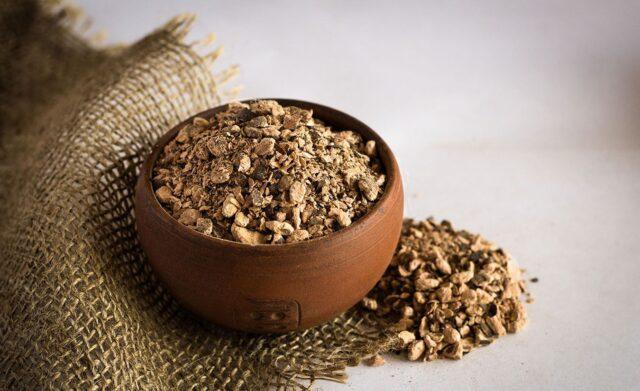
It is advisable to take medicines from the badan root without exacerbation of ulcers and gastritis
Badan for potency
You can brew incense to restore libido in men. At the first symptoms of a weakening of potency, it is useful to use such a remedy:
- dried leaves of a plant in the volume of three large spoons are poured with 500 ml of boiling water;
- bring to a boil on the stove;
- boil for half an hour and cool.
The warm agent is filtered from the sediment and diluted with fresh boiling water to the original volume. Take the drink, like regular tea, up to three times a day on a daily basis.
Recipes for useful compounds
Traditional medicine offers several general algorithms for the preparation of medicinal products from thick-leaved bergenia. You can use them for almost any ailment in accordance with the basic instructions.
How to brew badan leaves
A simple recipe for a decoction on the leaves of a medicinal plant looks like this:
- two small spoons of dried crushed raw materials pour 200 ml of boiling water;
- close the container with a lid and wrap it with a towel;
- insist until the product cools down;
- filter through cheesecloth, remembering to squeeze out the wet leaves.
You need to drink the infusion up to four times a day in a large spoon. The product is also suitable for external use - wipes and compresses.
How to brew badan roots
For most ailments, a decoction from the roots of a thick-leaved saxifrage has a good medicinal effect. The recipe looks like this:
- rhizomes are crushed in the volume of a large spoon;
- pour raw materials with a glass of water;
- simmer for half an hour;
- cooled to a warm state and filtered.
The broth is usually taken in a large spoonful three times a day, preferably on an empty stomach.
How to make badan leaf tea
There are many recipes for tea made from badan leaves. Such a drink is appreciated not only for its useful qualities, but also for its unusual pleasant taste.
Badan tea with honey and lemon
A simple tea based on badan leaves has a good strengthening effect. They do it like this:
- a small spoonful of dried raw materials is poured with a glass of boiling water;
- insist under the lid for 15 minutes;
- filter through a fine sieve.
To improve the taste, you need to put a spoonful of natural honey and a slice of lemon in the drink. Drink tea after meals or in between meals.
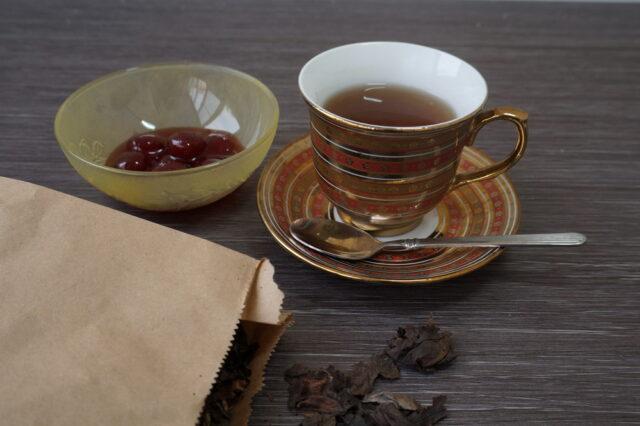
You can drink simple tea on the leaves of badan, as usual, up to three cups a day.
Chigir tea on badan leaves
The famous classic recipe suggests making a very concentrated drink with numerous medicinal properties. The algorithm looks like this:
- dried leaves in the amount of four large spoons are poured into 500 ml of water;
- bring to a boil over medium heat and leave for half an hour;
- remove the tea from the stove and cool slightly.
Then the product must be filtered and refilled with clean hot water to its original volume. The healing properties and contraindications of badan tea are of particular importance for colds.

Chigir tea should be consumed in case of inflammation
Badan and lingonberry tea
Badan and lingonberry combine well in taste and, moreover, significantly enhance each other's value. Drinking tea based on two plants is especially useful in case of weak immunity, diabetes mellitus and a tendency to edema.
The cooking recipe looks like this:
- two large spoons of badan are mixed with a large spoonful of lingonberry leaves;
- add a pinch of dried oregano;
- pour 500 ml of water;
- bring to a boil and immediately remove from the stove.
The drink is left to cool for about an hour, and then passed through folded gauze. If you want to take the product hot, you should top it up with fresh boiling water. A little honey can be added to the tea just before drinking.
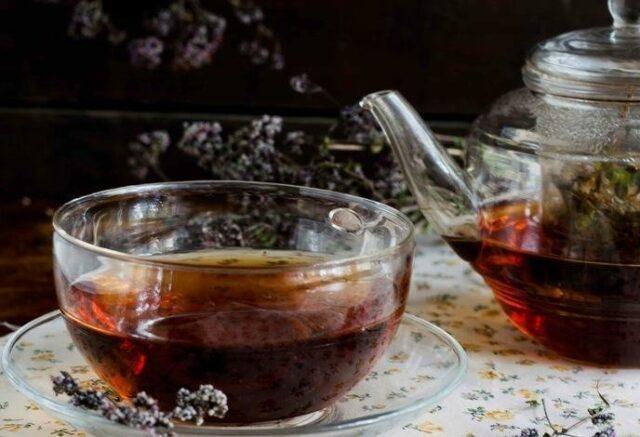
Oregano in tea with berry and lingonberry makes the aroma of the drink richer
Alcohol tincture of badan root
Alcohol tincture on perennial roots has strong medicinal properties. It is prepared according to this recipe:
- 50 g of crushed dry raw materials are poured into 400 ml of 70% alcohol;
- clog the container and put it in a dark, warm place for a month;
- from time to time they take out the vessel and shake it up properly.
After the time has elapsed, the finished tincture is removed and passed through cheesecloth. It is taken in accordance with specific recipes, on average - 30 drops up to three times a day.
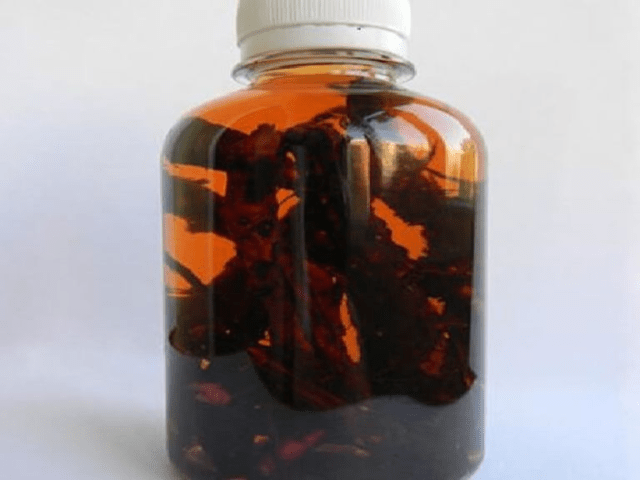
Before use, it is advisable to dilute the berserk tincture in a spoonful of water.
Extract
The concentrated extract of badan root has particularly strong beneficial properties. The drug is made as follows:
- rhizomes are crushed in a volume of three large spoons;
- pour raw materials with a glass of water;
- put in an enamel bowl over medium heat and cook until half of the liquid remains.
The rest of the extract must be filtered.Take it in minimal quantities - three times a day, a maximum of 30 drops. The tool can be used for douching and rinsing with angina, periodontal disease, stomatitis, in such cases, 15 ml of the extract must be diluted in a glass of water.
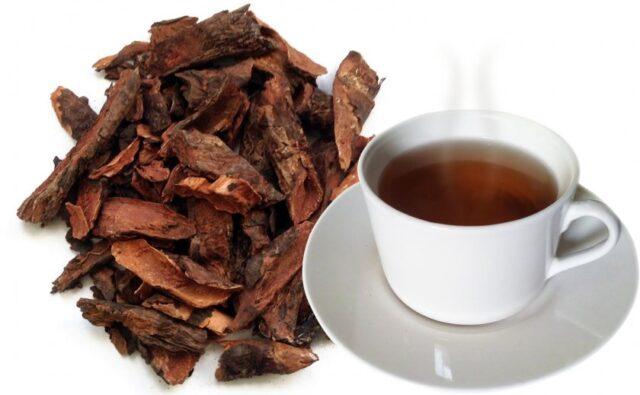
By the strength of the action, the berry extract is not inferior to alcohol tincture
Badan rhizome powder
It is very simple to prepare powder from the dry roots of bergenia. Raw materials are crushed using a blender or coffee grinder, and then stored in a glass container. You can use the powder for the preparation of decoctions and infusions.
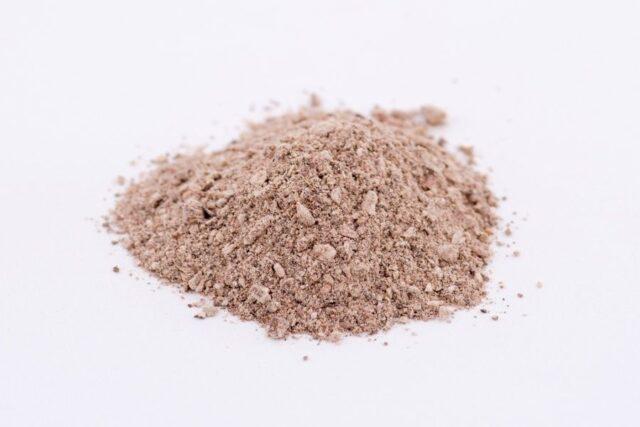
Badan powder can be diluted with water to a semi-liquid gruel and applied to the skin externally
Application of badan
Medicinal thick-leaved saxifrage is used not only in folk medicine. The plant benefits in the kitchen and in home beauty recipes.
In cooking
Badan rhizomes are used for culinary purposes. Dried and crushed, they are added to flour for baking, and when chopped, they are boiled in soups and fried along with main courses.
Badan has a pleasant taste and is also a dietary plant. When used correctly, it promotes weight loss and accelerates metabolic processes in the body.
In cosmetology
Badan infusions are used to rinse hair. Herbal teas help regulate the oiliness of the scalp and get rid of dandruff. Plant-based products are suitable for washing with oily type of epidermis and excessive sweating. Perennial helps to cope with acne, tightens pores and normalizes the production of subcutaneous fat.
Limitations and contraindications
The beneficial properties of the badan flower are not the same for everyone. The plant has certain contraindications, which include:
- hypotension;
- individual allergy to medicinal herbs;
- increased blood clotting and a tendency to thrombosis;
- tachycardia;
- frequent constipation;
- period of breastfeeding.
At the first use of the infusion or decoction from the roots and leaves of the plant, the minimum dosage must be observed. If a negative reaction does not appear, you can freely take badan for medicinal purposes.
When and how to collect and dry badan
Badan can be harvested both in the spring and closer to autumn - the timing and algorithms depend on which parts are to be used. Roots and leaf blades gain a maximum of valuable substances at different times.
Roots
Harvesting of underground parts of badan is carried out in August. The perennial is dug up, the rhizome is cleaned from the earth and washed in cold water.
Medicinal raw materials are dried in a standard way - in the fresh air in the shade or in the oven at a temperature not exceeding 45 ° C. The roots must be spread out in a thin layer so that they are less in contact with each other. The natural harvesting process takes about three weeks. Raw materials are stored in paper or fabric bags in the dark and dryness, the beneficial properties are retained for four years.
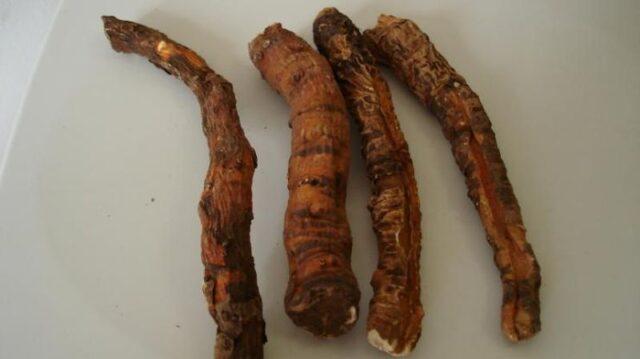
The large roots of the badan are cut into pieces of 10-15 cm long
Leaves
Leaves for medicinal use are plucked in spring and summer, optimally during the blooming berry. It is best to choose old darkened plates that have had time to winter at least once, they contain the most valuable substances. The plucked leaves are preliminarily kneaded a little, and then dried until the moisture evaporates on the baking sheet. You can leave them indoors, outdoors or in an oven preheated to 40 ° C.
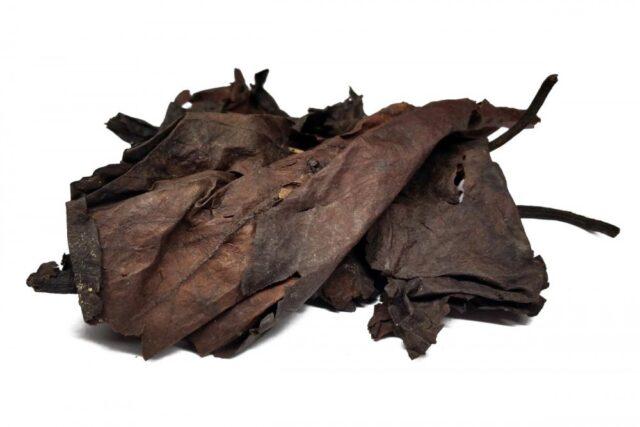
When properly harvested, the berry leaves should acquire a dark brown or black color.
It is best to store the leaves in glass jars in a dry, dark place. It is permissible to use them for medicinal purposes for two years.
Conclusion
The healing properties and application of bergenia deserve a lot of attention. The perennial plant helps with colds, has pronounced astringent properties and can stop bleeding.







